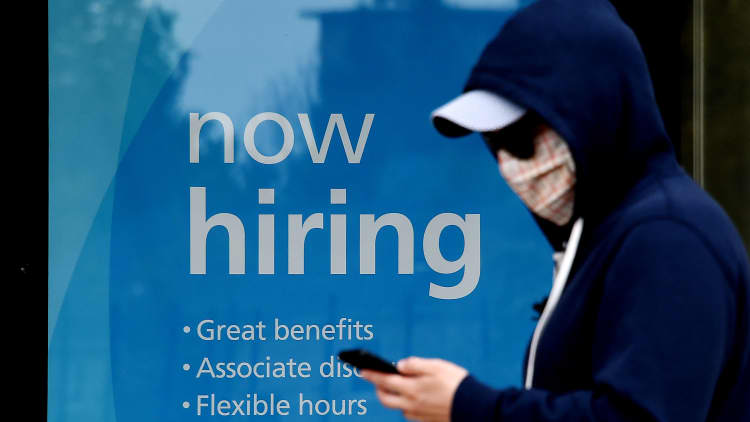The unemployment rate fell to 11.1% in June, exceeding expectations as U.S. businesses added a record number of Americans to their payrolls.
But what does the unemployment rate mean and why is it important?
Indicator of hardship
The unemployment rate measures how many people who want a job and are available for work can find a job.
June's unemployment rate indicates that roughly 1 in every 9 people in the labor force can't find work.
The unemployment rate is typically an indicator of hardship for American families, said Stephen Woodbury, a labor economist and professor at Michigan State University.
More from Personal Finance:
What the next relief bill might look like
Why the new PPP deadline may not help businesses
Here's how much Medicare could cost you in retirement
That's because an unemployed person's income drops after losing a job.
Unemployment insurance generally provides a temporary stopgap, but these state-administered benefits often replace less than half of prior wages. Many workers also aren't eligible for jobless pay.
Aside from April's unemployment rate of 14.7% and May's rate of 13.3%, the current rate is higher than at any other time since the Great Depression, when it peaked at more than 25%.
Nearly 18 million Americans were unemployed in June.
And the employment situation soured far more quickly than at any other point in history, doing so over the span of a few months. By comparison, it took more than a year for the Depression-era unemployment rate to witness an equivalent rise.
But the situation appears to be trending more positively — around 4.8 million Americans got jobs in the month between mid-May and mid-June, a record.
The Bureau of Labor Statistics attributes that to a "continued resumption of economic activity that had been curtailed in March and April due to the coronavirus pandemic and efforts to contain it."
Unemployment rate conundrum
The unemployment rate may not be the most accurate indicator of financial stress at the moment, however, Woodbury said.

A recent federal financial-relief law greatly increased unemployment benefits for out-of-work Americans. It offers an additional $600 a week through July in addition to typical state benefits and expands the pool of workers eligible for benefits.
While the unemployment rate right now is elevated, federal policy "has acted very quickly to try to head off a lot of the hardship that would otherwise result," Woodbury said.
"As a measure of hardship, it's not as good as it usually is," he added.
Of course, many Americans have struggled to access unemployment benefits amid record volume and administrative delays. And income may drop precipitously after July, barring an extension of $600-a-week stimulus from Congress.
In addition, the unemployment rate includes workers temporarily laid off (or furloughed). These workers are technically still attached to an employer and can return to work quickly if business rebounds.
Nearly 60% of the 17.8 million Americans out of work are furloughed — the third-largest share in history, behind the figures for April and May. That suggests the current unemployment picture could potentially reverse quickly if the job losses don't become permanent.
The unemployment rate also doesn't include the share of Americans who dropped out of the labor force because they were discouraged and decided not to look for work, for example.
A large share of people leaving the labor force would make the unemployment rate appear artificially low.
"That isn't necessarily good, because these are maybe people who are discouraged and would like a job but concluded they can't get one," Woodbury said.
The share of "discouraged workers" has increased slightly since April, rising by 107,000 workers to 681,000 individuals in June.
Other measures
Other measures may be more useful than the unemployment rate in demonstrating the relative employment hardship of Americans, according to some experts.
The employment-population ratio, for example, measures the share of employment among the entire adult population — not just those looking for work. It therefore captures adults who were discouraged about the prospects of finding a job, for example.
The ratio is perhaps the best snapshot of labor demand, or the number of jobs available for people, Woodbury said.
That share recovered a bit in June compared with April — growing to 54.6% from 51.3%, which was a historic low in the post-World War II era.


